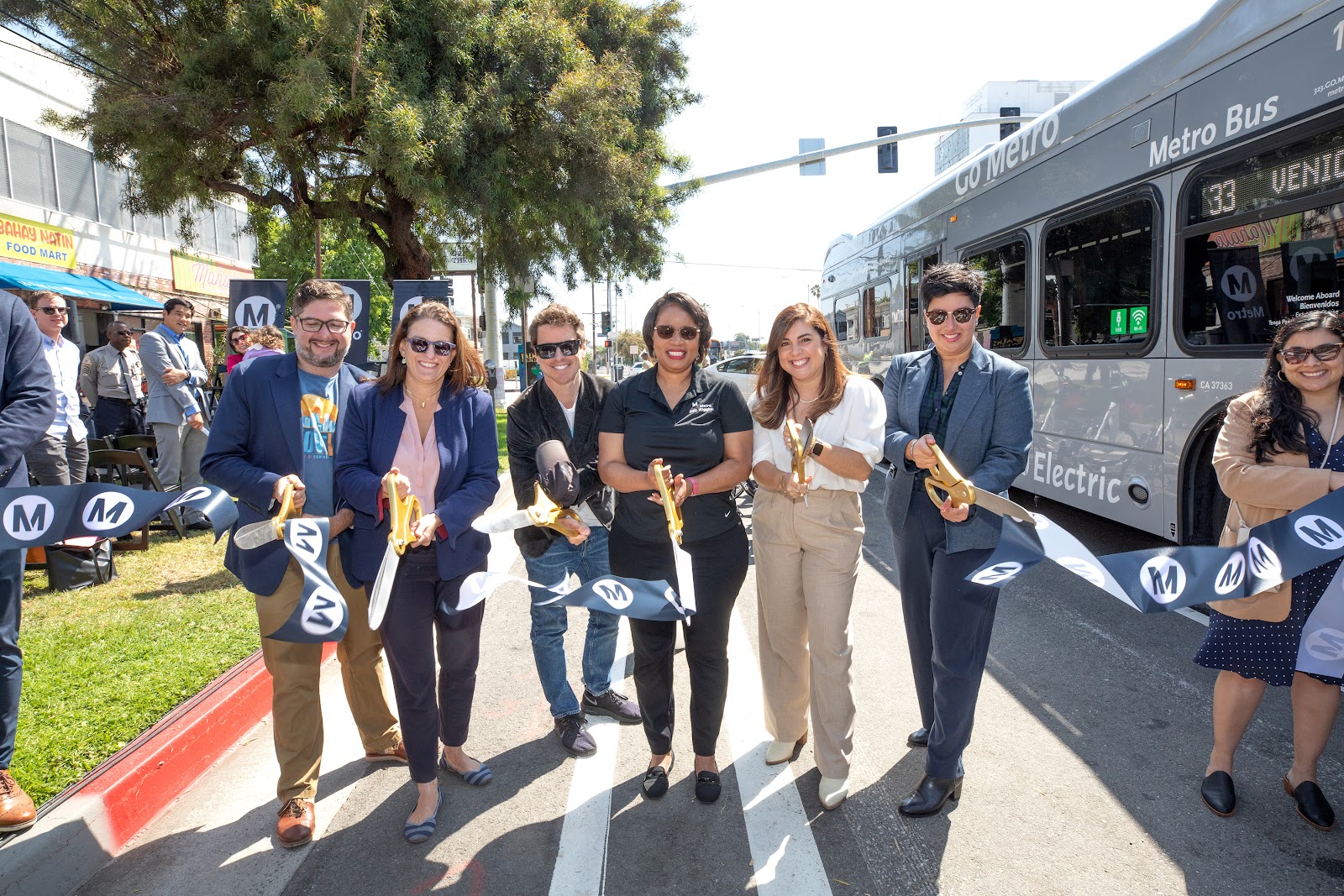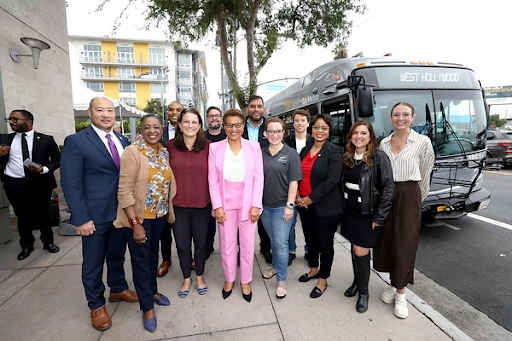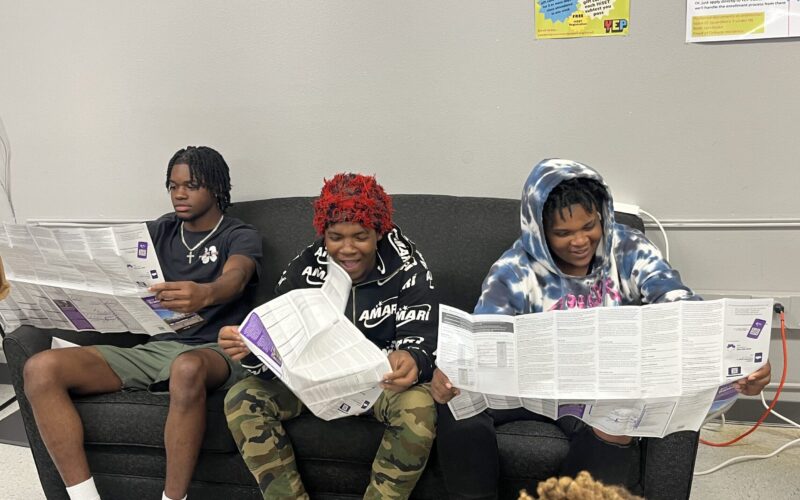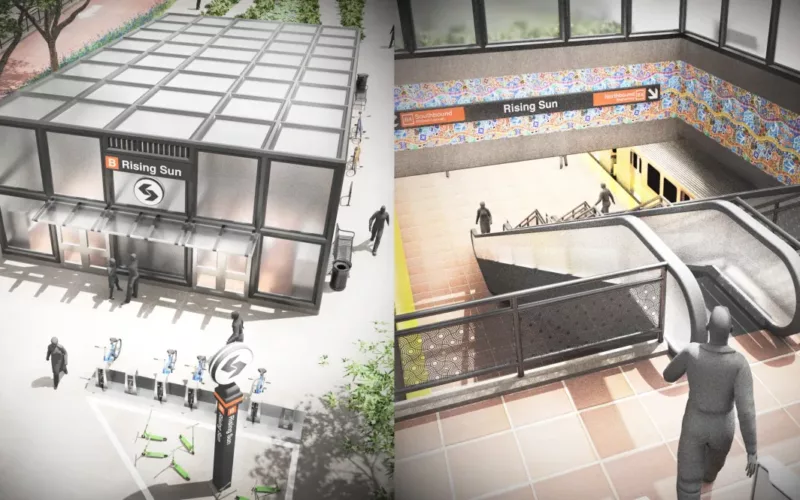
Ribbon cutting celebrating the opening of the La Brea bus priority lane in Los Angeles
This post was written by Eli Lipmen, Executive Director, Move LA
From Lancaster to Long Beach, Los Angeles County residents work hard for their families and should be able to rely on good public transit to keep them moving. But for too long, LA officials have favored the movement of cars over the movement of bus riders, resulting in some of the slowest buses in the country. LA Metro’s bus system carries 80% of its total ridership, and speeding up buses is essential to providing the majority of transit riders in LA with high-quality service.
The good news is that LA is starting to do just that. Thanks to the persistent work of local transit advocates, LA Metro has committed to improving bus speeds and is laying down 30 miles of bus lanes in 2023, pushing the total number of bus lanes in LA County to 40 miles.
This accelerating progress on bus lanes in LA has been years in the making, and can be traced to a coordinated advocacy effort that aggressively pushed for both funding and policies that led to better service, infrastructure that speeds up buses and makes routes more reliable, and amenities that benefited current riders. For other advocates hoping to push their cities and agencies to dramatically increase bus lane production, we hope our story can offer lessons and spark ideas.
“The work from our advocacy community is critical to our ambitious plan to deliver over 100 miles of bus priority lanes to improve Metro’s bus speed and reliability in the coming years,” said Metro Chief Operations Officer Conan Cheung. “I thank the advocacy community for their leadership in sparking authentic discussions and building broad support for these transformational projects that bring equity and sustainability to the forefront.”
NextGen
As recently as 2020, LA had just a handful of miles of bus lanes and the bus system was struggling, shedding riders at an alarming rate. In response to years of advocacy from groups like Move LA, ACT-LA, and the Bus Riders Union, Metro launched a process in 2018 called the NextGen Bus Plan to “reimagine” its bus system to meet the needs of current and future riders. But advocates knew that just passing a great plan wouldn’t necessarily result in actual changes on the ground.
We mobilized to ensure the plan was grounded in equity for bus operators while also being the most ambitious bus plan possible; attending community meetings, sending letters, meeting with key elected officials, and calling into public meetings. Move LA put together a coalition of 25 organizations to advocate for the plan and its promise of fast, frequent, and reliable bus service, pushing for Metro to expand service by at least 20%. This coalition consistently showed up at Metro meetings and Board meetings to make the case to approve the bus plan with the highest levels of planned service (a 20% increase) and over $1 billion in infrastructure investments over five years. Alliance for Community Transit-LA (ACT-LA) held town halls and a Transit Justice Summit. Investing in Place created the Better Buses for LA Working Group to convene monthly meetings of community members, organizers, public agency staff, advocates, and leaders to dig deep into bus routes, bus service, and the needs of riders. And Streets for All created a campaign for “Venice Blvd for All” to enhance Venice Blvd with bus and bike lanes.
In 2020, LA Metro’s Board approved the NextGen bus plan with overwhelming support.
However, the victory was short-lived; advocates quickly needed to turn their attention to the budget process to influence the spending necessary to implement the plan. Move LA began a campaign to win a “rider-focused” budget, writing letters and mobilizing riders, and campaigning for a vital Bus Rapid Transit project. ACT-LA, and SAJE held a “Budget Teach-in”, Investing in Place created a Budget 101 training, and Move LA produced a “Metro Budget Guide”. As a result, Metro budget staff began to meet regularly with advocates and, at our urging, started to include a line item and a report specifically for NextGen bus infrastructure investments.
When COVID hit, advocates had to shift gears, focusing their energy not just on the local level but the federal level, too. The Better Buses for LA Working Group continued to meet (virtually) and Metro started to use advocates’ messaging about #BetterBusesforLA as it rolled out its plan to improve buses. But the question remained unclear–would Metro actually implement its planned NextGen Bus Plan?
Saved by an “Inter-departmental Memo”
Ultimately, the development of an “Inter-Departmental Memorandum,”- an agreement on how the City of LA’s Department of Transportation —which owns the streets—and Metro—which runs the bus service— would work together was essential to moving NextGen forward. Written by LA Department of Transportation staff at the request of former City Councilmember and Metro Board member Mike Bonin, the memorandum created a framework for Metro to work with the City to plan, build, operate, and maintain bus lanes.
Metro and LADOT began to move on the memo and directives of elected officials, adding staff for outreach and coordination to ‘lay the pavement’ (pun intended!) to implement more ambitious bus lane projects and put them in at a much quicker pace. This had an almost immediate desired effect, dramatically speeding up buses on corridors like Flower Street in Downtown LA, where nearly 70 buses an hour benefit from the bus lane. The reaction—from businesses to bus riders—was overwhelmingly positive and this gave planning staff at Metro and LADOT the confidence to tout the success of this effort, especially how quickly they were able to implement these changes. The one group unhappy with the changes were automobile drivers, many of whom would cut into the bus/bike lane to get around traffic. At the urging of advocates and Metro, the City began enforcement actions, ticketing those using the bus/bike lane for personal auto use.
The success of that first year of implementation in 2020/21 led Metro to expand the NextGen Speed and Reliability Program under the leadership of the new COO, Conan Cheung, who happened to be the project leader of the NextGen Bus Plan. This small team—Stephen Tu, Julia Brown, and James Shahamiri—worked with LADOT staff and council offices to accelerate the bus lane projects. And they began to regularly update and meet with advocate groups and local bus riders–seeking ideas, and recommendations about local groups to engage, and getting on the bus to talk with riders. This team became adept at meeting with local businesses and nonprofits, too, to address concerns about traffic, and parking, and digging deep into how their workers–particularly workers who rely on transit –got to and from work.
2023: The year when bus lanes took off
2023 is when LA really started to see bus lane infrastructure accelerate outside of the downtown area. Just two weeks ago, Move LA and other advocates joined Metro and local elected officials to open 4.9 miles (2.45 miles end to end) of bus priority lanes on La Brea Avenue, the first bus lane implemented outside the City of Los Angeles (LA County has 88 total cities), serving the 9,000 daily riders that use Line 212 each day to travel between the cities of West Hollywood, LA, and Inglewood.

Move LA Executive Director Eli Lipmen joined elected officials, the CEO and staff of Metro, and LADOT staff to officially open new LA Brea bus priority lanes.
Getting NextGen improvements in Metro’s budget
Each individual bus lane is a HUGE victory for bus riders along these routes, creating more reliability, frequency, and speed to get riders where they need to go. However, advocates knew that the real prize would be getting the Metro annual budget to include a line item for NextGen bus improvements and for overall bus investments.
This step required a lot of ‘behind the scenes’ work–monthly meetings with the chair of Metro’s team led to policies directing Metro’s budget staff to include bus investments as a line item. This led to meetings between advocates and the budget staff. Advocates learned about the ‘Catch-22’–budgeting for bus lanes was based on previous years’ expenditures, but because of the slow pace of implementation, not much was budgeted! So advocates had to continue to push for planned bus lanes to be implemented to get more money budgeted.
After months and years of advocacy –sometimes at the same monthly budget and finance committee meeting with the same message–Metro board members began to push Metro budget staff publicly to include a breakdown of bus expenditures in the annual budget.
And it happened! As of 2021, Metro’s annual budgeting process now outlines where Metro plans to invest in the bus network, every year:
What’s next for LA bus advocacy?
Move LA’s big vision is to see Metro and LADOT close travel time gaps for bus riders across the country and create a more comfortable and safer waiting environment. The NextGen Bus Plan set aggressive goals like providing 80% of bus riders with 10-minute or better frequency and so that is the next metric to achieve. We need to see more bus lanes go from planning documents to the pavement, and our continued advocacy for expanding the bus infrastructure budget will be vital. We still have a long way to go before the majority of LA bus riders are speeding to their destination in a bus lane, but how far we’ve come in a short time is a testament to the power of community organizing, building partnerships with planners, and prioritizing the needs of bus riders. By raising our voices together, we showed that it was possible for our city to prioritize transit riders – not just people in cars.
 Winning Free Fares for Youth in New Orleans
Winning Free Fares for Youth in New Orleans
Most transit agencies rely on fare revenue to fund operations, meaning many are forced into the position of needing to collect fares from the people who can least afford it. To change this paradigm, advocates across the country are fighting for - and winning - programs that allow agencies to zero out fares for youth, removing one of the largest barriers to youth ridership.
Read More To Achieve Justice and Climate Outcomes, Fund These Transit Capital Projects
To Achieve Justice and Climate Outcomes, Fund These Transit Capital Projects
Transit advocates, organizers, and riders are calling on local and state agencies along with the USDOT to advance projects designed to improve the mobility of Black and Brown individuals at a time when there is unprecedented funding and an equitable framework to transform transportation infrastructure, support the climate, and right historic injustices.
Read More
